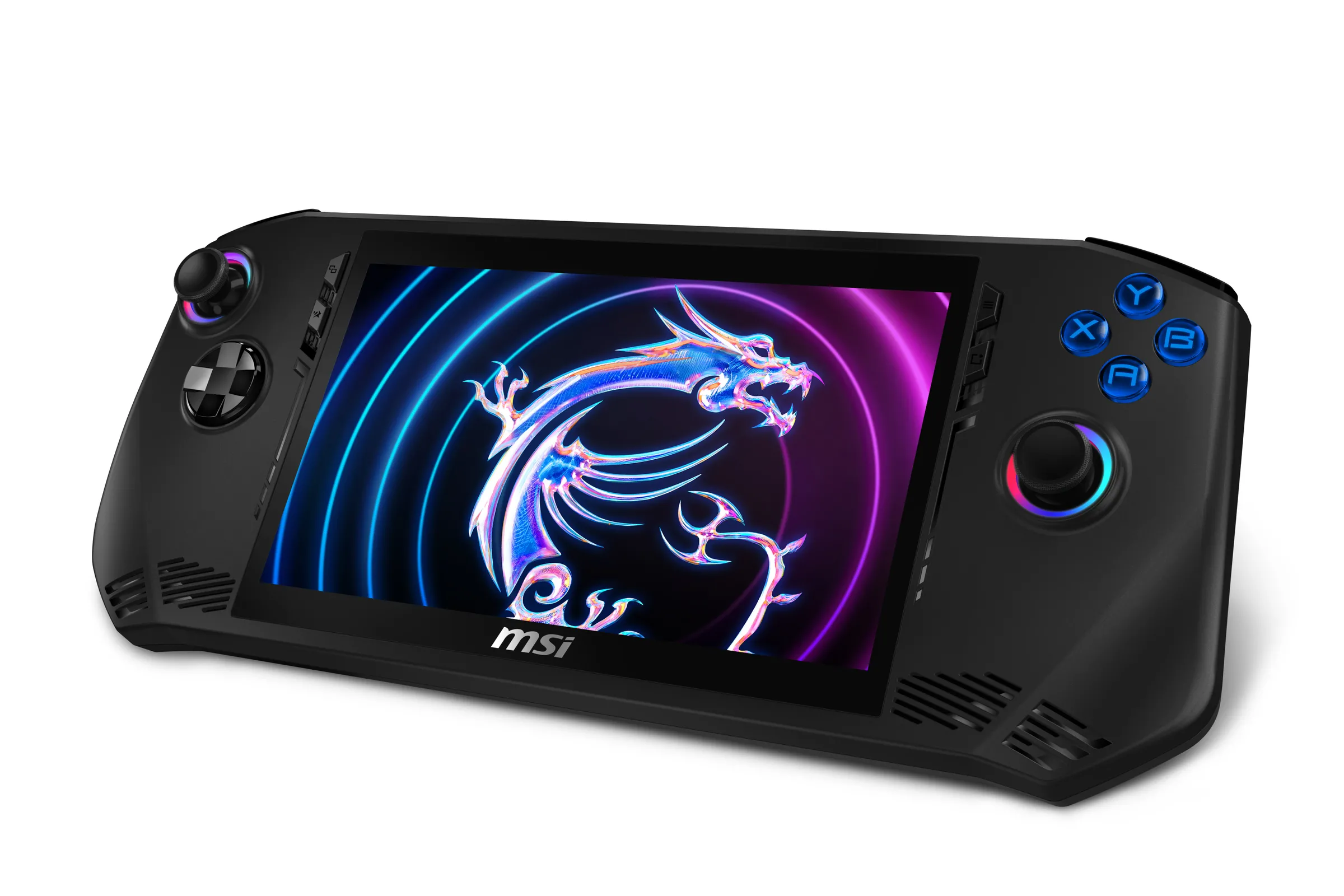MSI Claw vs Steam Deck – an Intel-powered rival

Table of Contents
Valve set a new industry standard for handhelds with its portable gaming PC, so let’s see if MSI’s new contender is up to scratch by comparing the MSI Claw vs the Steam Deck. About two years on from the Steam Deck’s initial launch, MSI has announced its first handheld gaming PC at CES 2024. While the portable gaming PC is a niche genre, the competition is fierce, and now we’ve got a new name in the mix – the MSI Claw. This article will delve into the features, specifications, and performance of the MSI Claw, to see if MSI’s Intel-powered handheld has the design flair and specs to overthrow the latest Steam Deck.
MSI Claw vs Steam Deck specs
| Specs | MSI Claw | Steam Deck OLED |
|---|---|---|
| Display | 7” FHD (1920×1080), 120Hz, IPS-Level Touchscreen | 7.4-inch HDR OLED (1280 x 800) |
| Dimensions | 294 x 117 x 21.2mm | 298mm x 117mm x 49mm |
| Weight | 675 g | 640 g |
| CPU | Intel Core Ultra 5 / Intel Core Ultra 7 | 6 nm AMD APU |
| Graphics | Intel Arc Graphics | 8 RDNA 2 CUs |
| Memory | 16GB LPDDR5-6400 RAM | 16GB LPDDR5 RAM |
| Storage | Up to 1TB (MicroSD slot) | 512GB, 1TB (MicroSD slot) |
| Battery | 53 Battery (Whr) | 50Whr |
| Operating system | Windows 11 | SteamOS |
MSI Claw vs Steam Deck features
Design and physical features
Both the MSI Claw and the Steam Deck follow a similar template in terms of dimensions and layout, and visually speaking these devices look quite alike in their form factors. However, there are some key differences in their physical features. The Claw stands out with its shoulder buttons, hall effect triggers, and thumbsticks which are designed to be immune to stick drift, giving it an advantage over its competitors. The most eye-catching element of the MSI Claw is that its thumbsticks and four face buttons are illuminated by rainbow RGB lighting, bringing that MSI-flair that’s missing from its rival.
Prime Day is finally here! Find all the biggest tech and PC deals below.
- Sapphire 11348-03-20G Pulse AMD Radeon™ RX 9070 XT Was $779 Now $739
- AMD Ryzen 7 7800X3D 8-Core, 16-Thread Desktop Processor Was $449 Now $341
- ASUS RTX™ 5060 OC Edition Graphics Card Was $379 Now $339
- LG 77-Inch Class OLED evo AI 4K C5 Series Smart TV Was $3,696 Now $2,796
- Intel® Core™ i7-14700K New Gaming Desktop Was $320.99 Now $274
- Lexar 2TB NM1090 w/HeatSink SSD PCIe Gen5x4 NVMe M.2 Was $281.97 Now $214.98
- Apple Watch Series 10 GPS + Cellular 42mm case Smartwatch Was $499.99 Now $379.99
- ASUS ROG Strix G16 (2025) 16" FHD, RTX 5060 gaming laptop Was $1,499.99 Now $1,274.99
- Apple iPad mini (A17 Pro): Apple Intelligence Was $499.99 Now $379.99
*Prices and savings subject to change. Click through to get the current prices.
In terms of grip, the Claw offers a deep and comfortable hold, although not as deep as the Steam Deck. Both devices offer ergonomic and comfortable experience, and are also fairly evenly matched when it comes to dimensions and weight, with the Claw being just slightly heavier than the Deck at 675 grams compared to 640. One of the few advantages the Steam Deck holds here is its inclusion of a touch pad designed for mouse use, a useful feature not used by MSI.
Display and resolution
When it comes to the display, both the MSI Claw and the Steam Deck offer an upgrade over the competition, although the elephant in the room is that one of them is OLED, which provides a far better viewing experience. The Steam Deck 7.4-inch OLED display is one of the best currently offered on a handheld, proving the deep blacks and contrasts that make your gaming better. However, its resolution is still capped at 1280×800 and 90 Hz, even with this new OLED version.
On the other hand, the MSI Claw boasts a 7-inch display with a 1080p resolution, providing users with crisp and detailed visuals at peaks of 120 Hz. Not to mention, the Claw also leverages Intel XeSS, the company’s upscaling technique equivalent of Nvidia DLSS. So, it’s a bit of a throwdown between OLED and refresh rate, and while it seems that the Claw could be better for fast-paced gaming, a bit of hands-on experience is required to make a full conclusion. It’s also worth mentioning that the Lenovo Legion Go surpasses them all with its 8.8-inch QHD screen.
MSI Claw vs Steam Deck – performance and hardware
The performance of a gaming handheld is crucial, and this is where the MSI Claw aims to make its mark. It is powered by an Intel Core Ultra 5 or Core Ultra 7 processor, equipped with integrated Intel Arc graphics. This combination promises to deliver more power than the Valve Steam Deck, who’s 6nm custom AMD APU wasn’t a massive upgrade from its original 7nm APU. Although this boosted efficiency, on paper so far it seems that the Claw could be the more powerful of the two here.
However, it remains to be seen whether Intel’s integrated graphics can match the performance of AMD’s offerings, and it’s not clear that the Meteor Lake chip can surpass the tried and trusted Ryzen Z1 Extreme. The integration of Intel guts also grants the Claw access to Thunderbolt 4, expanding its potential for external graphics and display options. To top it off, not only does the Claw have the advantage of Wi-Fi 7 compatibility, the back of the device also has a cooling system that MSI claims is 50% larger than the likes of the Steam Deck, Asus ROG Ally, and Legion Go. So, we’re potentially looking at a more optimized device that stays cooler under heavy workloads.
MSI Claw vs Steam Deck – software and interface
In terms of software, the Steam Deck stands out as the biggest outlier. It features a Linux-based interface developed by Valve, known as SteamOS. This interface has been successful in running Windows-based games through its Proton compatibility layer, but it seems many players end up going down the complicated route of installing Windows onto their device as opposed to using Linux.
On the other hand, both the MSI Claw runs Windows 11 natively, with custom MSI UI software overlaying the interface. This allows users to browse and launch games, as well as customize controls. The Claw, based on Intel hardware, offers the advantage of Thunderbolt 4 on its USB-C port, potentially providing better options for external graphics and displays.
Battery life and cooling
Battery life is a crucial consideration for portable gaming devices, and naturally, the MSI Claw aims to deliver in this aspect too. With a 53Wh battery capacity, it surpasses the Steam Deck, which has a 50Wh battery. While MSI claims that the Claw can last for approximately two hours of gameplay with Forza Horizon 5, real-world battery tests will provide a more accurate assessment once we see the full launch.
We’re not sure exactly how many hours of battery life you’ll be able to squeeze out of the Claw yet, but MSI’s claim that it can go two full hours under a heavy workload suggests the device is targeted more specifically at gamers who want to take their AAA titles with them on the go. The more versatile Steam Deck pledges to provide three to twelve hours of gameplay depending on the content.
MSI Claw vs Steam Deck – pricing and availability
The MSI Claw is expected to be released in the first half of 2025, and we’re just starting to get some regional launch dates. With a launch coming in the UK on the 20th of March, it’s possible to presume that the handheld will start arriving elsewhere around the beginning of April.
As expected, it will be available in a few different configurations offering different storage and CPU variants, which push the price up by a further few hundred dollars. The cheapest Core Ultra 5 and 512GB storage model costs $699. The higher-end models, equipped with the powerful Core Ultra 7 processor, come in at $749 for 512GB and $799 for 1TB storage.
On the other hand, the Steam Deck OLED price point starts at $549 for this refreshed model, but you can still purchase an original LCD Steam Deck for $349. So, if price is a concern for you, you can actually get a Steam Deck for sub $400 if you don’t mind going for the LCD over the OLED.
MSI Claw vs Steam Deck – which one should you go for?
The MSI Claw enters the portable gaming PC market as a strong contender against the Steam Deck. With its unique features, such as hall effect thumbsticks and rear triggers, as well as its larger battery capacity, the Claw offers gamers a compelling option for those venturing into the realm of handhelds. Its display, performance, and software capabilities certainly make it a device worth considering. Yet, it remains to be seen how the Claw will fare in head-to-head comparisons and benchmark tests against existing portable gaming PCs, most notably, the dominating Steam Deck OLED. In terms of which one to go for, the Steam Deck OLED is a solid choice with a stellar reputation, but without the full release of the MSI Claw, it’s hard to make a decisive verdict.



